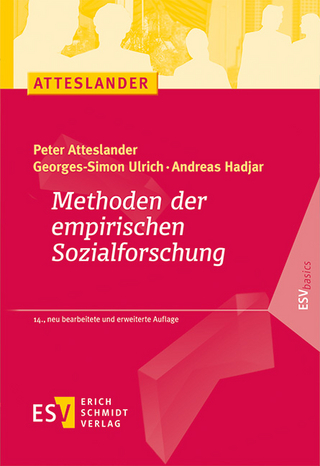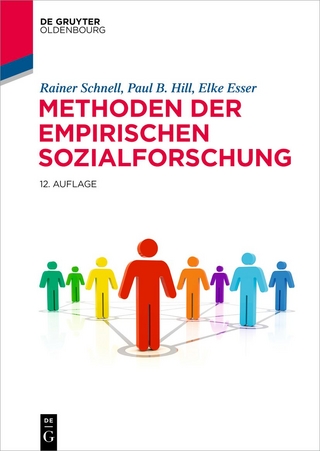
Real World Research
John Wiley & Sons Inc (Verlag)
978-1-4051-8241-6 (ISBN)
Real world research is a common responsibility of professionals and practitioners in a wide range of both public and private settings. These include teachers, social workers and health service professionals, managers and specialists in business, architects, designers, criminologists and accountants among many others.
Real World Research provides a clear route-map of the various steps needed to carry out a piece of applied research to a high professional standard. It is accessible to those without a social science background while providing rigorous and fully up-to-date coverage of contemporary issues and debates. It brings together materials and approaches from different social science disciplines, seeing value in both quantitative and qualitative approaches, as well as their combination in mixed-method designs.
Updated throughout, the third edition includes:
A brand new chapter on multi-strategy designs
Increased coverage of ethical issues
A chapter on writing a project proposal
Discussion of internet-based research - both as a research tool and as a subject for research
Coverage of evidence-based approaches - seeking to present a balanced assessment of their value
Colin Robson's bestselling textbook is essential reading for many higher education courses, at both undergraduate, taught postgraduate and doctoral level, as well as practitioners and others carrying out a research project as part of their job. A very extensive website, which is closely keyed in to the text, provides additional resources including copious examples of research and further discussion of research issues, links to other useful resources and selected journal articles, annotated lists of further reading and an extensive set of PowerPoint slides.
Colin Robson is a Professor in the Centres for Applied Childhood Studies and Evaluation Studies at Huddersfield University, and chief consultant to a major international project on the education of children with disabilities, difficulties and disadvantages, OECD, Paris. He is the author of How To Do A Research Project (Blackwell 2006).
Preface. Acknowledgements.
Ways of using the book.
The main steps when carrying out a project.
PART I SETTING THE SCENE.
Keeping a research journal.
Chapter 1 Introduction.
What is real world research?
Design matters.
Evaluation and change.
The audience for this book.
Returning to the real world.
Beginning the journey.
Chapter 2 Approaches to Social Research.
Introduction.
Postmodernism and extreme relativist approaches.
The two traditions: quantitative and qualitative social research.
The quantitative paradigm.
The qualitative paradigm.
Paradigms and research questions.
A pragmatic approach.
Multi-strategy research designs.
Realism and real world research.
The purposes of research.
Practical value of the theoretical material covered in the chapter.
PART II PLANNING: SELECTING A STRATEGY.
Chapter 3 Developing Your Ideas.
Introduction.
Deciding on the focus.
Searching and reviewing the literature.
Research questions.
Developing your research question(s).
The place of theory.
Chapter 4 General Design Issues.
Introduction.
A framework for research design.
Getting a feel for design issues.
Choosing a research design strategy.
Establishing trustworthiness.
Chapter 5 Fixed Designs.
Introduction.
General features of fixed designs.
Establishing trustworthiness in fixed design research.
Experimental fixed designs.
True experiments.
Quasi-experiments.
Single-case experiments.
Non-experimental fixed designs.
Sample size in fixed designs.
Chapter 6 Flexible Designs.
Introduction.
General features of flexible designs.
Research traditions in qualitative research.
Case studies.
Ethnographic studies.
Grounded theory studies.
Other traditions.
Sampling in flexible designs.
Establishing trustworthiness in flexible design research.
Chapter 7 Multi-strategy (Mixed Method) Designs.
Introduction.
The quantitative–qualitative incompatibility thesis.
The mixed methods movement.
Types of multi-strategy designs.
Designing and carrying out multi-strategy research.
Pragmatism, realism or 'anything goes'?
Dealing with discrepancies in findings.
Chapter 8 Designs for Particular Purposes: Evaluation, Action and Change.
Introduction.
Evaluation research.
Action research.
Intervention and change.
Researchers and practitioners.
Chapter 9 Ethical and Political Considerations.
Introduction.
Ethical codes and guidelines.
Ethical issues.
Researcher safety and risk.
Working with vulnerable groups.
General ethical responsibilities.
Ethical review boards and committees.
Politics and real world research.
Sexism and social research.
PART III TACTICS: THE METHODS OF DATA COLLECTION.
Selecting the method(s).
Chapter 10 Surveys and Questionnaires.
Introduction.
Designing surveys.
Carrying out a sample survey.
Designing and using a questionnaire.
Diaries.
Sampling in surveys – and elsewhere.
Probability samples.
Non-probability samples.
Chapter 11 Interviews and Focus Groups.
Introduction.
Types and styles of interviews.
General advice for interviewers.
Content of the interview.
Carrying out different types of interview.
Focus groups.
Dealing with interview data.
Skills in interviewing.
Chapter 12 Tests and Scales.
Introduction.
Measurement scales.
Other scaling techniques.
Using existing tests and scales.
Developing your own test.
Chapter 13 Observational Methods.
Introduction.
Observation in real world research.
Approaches to observation.
Participant observation.
Getting started as a participant observer.
Structured observation.
Deciding on a coding scheme.
The use of existing coding schemes.
Developing your own scheme.
Coding sequences of behaviour.
Reliability and structured observation.
Chapter 14 Additional Methods of Data Collection.
Introduction.
Unobtrusive measures.
Content analysis of documents.
Secondary data analysis.
Introduction to a range of more specialist techniques.
Internet-based research.
Feminist research methods.
Using multiple methods.
Chapter 15 Writing a Project Proposal.
Introduction.
How to recognize a good proposal.
The content of a research proposal.
The problem of pre-specifying flexible design studies.
Shortcomings of unsuccessful proposals.
Sources of funding.
PART IV CARRYING OUT THE PROJECT: ARRANGING THE PRACTICALITIES.
Know what you are doing before starting the data collection.
Negotiating access.
Get yourself organized.
Pilot if at all possible.
Work on your relationships.
Don't just disappear at the end.
Don't expect it to work out as you planned.
PART V DEALING WITH THE DATA.
Collecting the data.
Analysing and interpreting data.
Realist analysis and interpretation.
Preparing for analysis.
Analysis or interpretation?
Quantitative and qualitative data – and their integration in multi-strategy designs.
Chapter 16 The Analysis and Interpretation of Quantitative Data.
Introduction.
Creating a data set.
Starting data analysis.
Exploring the data set.
Exploring relationships between two variables.
Exploring relationships among three or more variables.
Analysing differences.
Quantitative analysis and different fixed design research strategies.
Chapter 17 The Analysis and Interpretation of Qualitative Data.
Introduction.
Types of qualitative analysis.
Using the computer for qualitative data analysis.
Dealing with the quantity of qualitative data.
Thematic coding analysis.
Data analysis in grounded theory studies.
Alternative approaches to qualitative analysis.
Integrating qualitative and quantitative data in multi-strategy designs.
Chapter 18 Reporting and Disseminating.
Introduction.
Reporting what you have found.
Ethics and reporting.
Reporting fixed design research.
The scientific journal format.
Reporting flexible design studies.
Reporting on multi-strategy design studies.
Reporting on case studies.
Writing for non-academic audiences – the technical report.
Alternative forms of presentation.
Writing skills.
Appendix A: Using Specialist Software for Quantitative Analysis.
Appendix B: Using Specialist Software for Qualitative Analysis.
Glossary.
References and Author Index.
Subject Index.
| Erscheint lt. Verlag | 4.3.2011 |
|---|---|
| Verlagsort | New York |
| Sprache | englisch |
| Maße | 181 x 251 mm |
| Gewicht | 1304 g |
| Themenwelt | Geisteswissenschaften ► Psychologie |
| Naturwissenschaften ► Chemie | |
| Sozialwissenschaften ► Soziologie ► Empirische Sozialforschung | |
| ISBN-10 | 1-4051-8241-5 / 1405182415 |
| ISBN-13 | 978-1-4051-8241-6 / 9781405182416 |
| Zustand | Neuware |
| Informationen gemäß Produktsicherheitsverordnung (GPSR) | |
| Haben Sie eine Frage zum Produkt? |
aus dem Bereich


